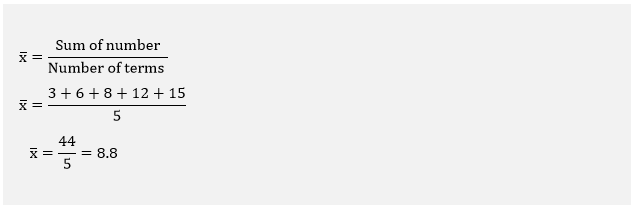MeanMean DefinitionThe mean in math can be defined as the sum of all observations in the distribution divided by the number of observations. The other definitions of the mean are: it is the average of the numbers or the sum divided by the count, is called mean. It is also known as the arithmetic mean. It is denoted by x (read as x bar). The other types of the mean are Geometric mean and Harmonic mean, and weighted mean. In statistics, the arithmetic mean is commonly used as the single value typical of a set of data. The arithmetic mean is also used in diverse fields such as anthropology, economics, and history. In economics, it is used to calculate per capita income (average income of a nation's population). How to Calculate MeanThe calculation of mean is very easy. It is the same as finding the average.
Mean Formula
OR 
Where n is the number of terms, and ∑xi is the sum of terms. The above formula can be written as: 
Where n is the number of terms. Properties of Mean
Let's see some examples that are based on the above formulas. Example 1: Find the mean of the following values. 19, 28, 43, 74, 73, 16, 12, 3, 7 Solution: Number of terms = 9 Sum of numbers = 19 + 28 + 43 + 74 + 73 + 16 + 12 + 3 + 7 = 275 We know that, 
The mean of the given series is 30.55. Example 2: Find the mean of the following values. 3, 6, 8, 12, 15 Solution: Number of terms = 5 We know that, 
The mean of the given series is 8.8. Example 3: Calculate the mean of the following: 105, -67, 20, 45, 120, -55, 34, -2, -22, 27 Solution: Number of terms = 10 We know that, 
The mean of the given series is 20.5. Example 4: The salaries of the employees are given, find the arithmetic mean of the salary. 5200, 5600, 2300, 7000, 2200, 4000 Solution: Number of terms = 6 We know that, 
The mean of salaries is Rs. 4383.33. Example 5: The height of five students is 160 cm, 167 cm, 155 cm, 150 cm, 144 cm. Find the arithmetic mean of the height. Solution: Number of students = 5 According to the formula: 
The mean of height is 155.2 cm.
Next TopicMode
|
 For Videos Join Our Youtube Channel: Join Now
For Videos Join Our Youtube Channel: Join Now
Feedback
- Send your Feedback to [email protected]
Help Others, Please Share











